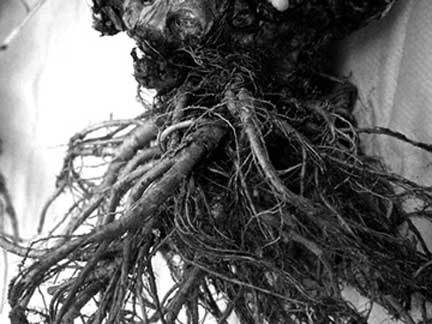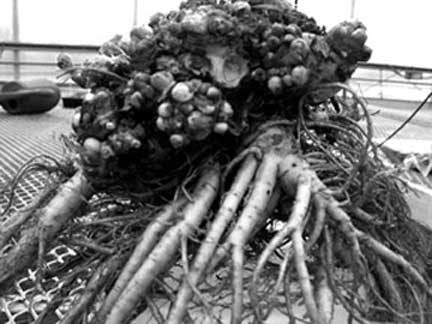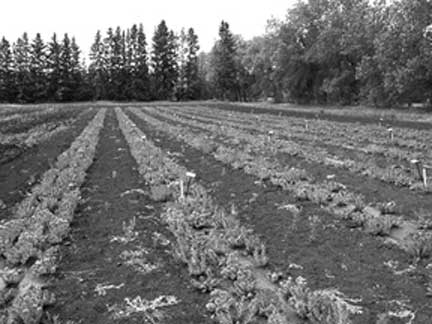| | Uses | Wild or cultivated | Agronomy | Quality | Markets | Seed sources | Future prospects
Rhodiola rosea is a perennial plant found in cool temperate and sub-arctic areas of the northern hemisphere. It is commonly referred to as golden root, arctic root or rose root. The common name rose root refers to the roots having the scent of rose petals, and the term golden root suggests the plant’s perceived value.
The plant normally grows in the arctic areas of northern Europe and Asia and is native to Russia and south Siberia. In Canada, it is found along the Newfoundland coastline as well as in Northern Quebec and Nunavut. There are many Rhodiola species, including Rhodiola intergrifolia, found in the Rocky Mountains in Alberta. Rhodiola rosea is by far the most common species used in the natural health product industry. The other species do not contain the medicinal properties of Rhodiola rosea.
Rhodiola rosea is an arctic herb and could be cultivated in colder areas of Canada where few other plants of economic importance can be grown without protection. It is hardy to zone one and is not frost tender once established.
Uses
Rhodiola rosea is a popular plant in traditional medical systems in Eastern Europe and Asia. Roots are the part normally used in trade (Figure 1). After the plants are harvested, washed and chipped, they are dried. The dried roots then undergo extraction processes to remove the bioactive compounds.
Extracts of the roots have a reputation for stimulating the nervous system, relieving depression, enhancing work performance, improving cognition and memory function, eliminating fatigue and preventing high altitude sickness. The extract has been classified as an adaptogen. In simple terms, an adaptogen helps produce adjustments in the body to resist stress (e.g. chemical, biological, and physical). In addition, Rhodiola rosea also contains a range of antioxidant compounds.

Figure 1. Rhodiola rosea roots have bioactive compounds.
Wild or Cultivated
The supply of Rhodiola rosea on the world market is limited and is being met mostly by harvesting from plants growing in the wild. It is unlikely that the wild harvest can continue to meet the growing demand. It is projected that the demand for Rhodiola rosea is greater than the current available supply, and future demand is expected to grow significantly.
Alberta, Finland and Norway are in the forefront of developing Rhodiola rosea plants from cultivated sources. Alberta Agriculture and Rural Development began an initiative to commercialize Rhodiola rosea in Alberta in 2004 and has since successfully built the foundation for the plant’s cultivation, processing and marketing.
Rhodiola rosea has been cultivated with success at several locations in central and northern Alberta including Barrhead, Berwyn, Cremona, Edmonton, High Prairie, Millet, Neerlandia, Peace River, Rocky Mountain House, Ryley and Two Hills. In Alberta, it is estimated that at least 30 ha (75 acres) of Rhodiola rosea in various stages of growth are already in production. This acreage makes Alberta the leading supplier of cultivated Rhodiola rosea in the world.
Agronomy
Rhodiola plants are perennial herbs growing up to 45 cm high. They have succulent leaves on numerous leafy stems and succulent rhizomes. The plants are either male or female. However in Alberta, many plants have both male and female flowers (hermaphrodites).
The plants have buds at the soil surface. These “buds” are the vegetative means of surviving from year to year. While the aerial leaves and stem, die they are replaced annually by the buds (Figure 2).

Figure 2. Buds are the means of survival.
Rhodiola rosea is currently wild crafted; as result, there is limited information on its cultivation. Research and production practices in Alberta have adopted an organic production system to be close to wild crafted sourced roots.
Due to its large root system, Rhodiola rosea requires deep soils. Loam or sandy loam soils are suitable. Rhodiola rosea does well under moderately rich and well drained soils, which are neutral to slightly acidic (pH 6 to 7). Propagation is either from crown divisions or plugs.
It is recommended that growers transplant two-year-old seedlings in early spring to take advantage of moisture and melting snow. This practice of transplanting two-year-old seedlings has several advantages. It reduces the number of years it takes the crop to reach maturity, reduces weeding and reduces field cost.
While the plant is drought tolerant, a water supply is required, either from natural rainfall or from irrigation at transplanting. Unlike echinacea, there is no winterkill in Rhodiola rosea: six years of growth showed only small differences in the number of plants per hectare.
Controlling weeds before planting is an essential part of weed management in Rhodiola rosea. Plasticulture (using plastic mulch in crop production) is a useful practice for Rhodiola rosea production. In addition to water conservation, plasticulture provides weed control on the mulched beds. It is still necessary to control weeds growing in the holes in the plastic with Rhodiola rosea.
It is probable that when properly timed, one weeding may provide adequate weed control in Rhodiola rosea under plasticulture. Research is currently being done on using organic means for weed control.
Plants are usually spaced at least every 30 cm (12 inches) within each row. There are three rows of plants per standard width of plastic mulch, giving a rate of 53,800 plants per linear ha (21,780 plants per linear acre)(Figure 3). In recent research, Rhodiola rosea did not appear to need much in the way of external sources of nitrogen, phosphorus, potassium and sulphur fertilizers.

Figure 3. Plant row spacing.
Rhodiola rosea is grown as a perennial, but the roots are harvested once at the end of four or five years. The root yield continues to increase throughout the five-year period. To ensure the continuous supply required by buyers, growers must establish a new plantation every year.
Specialized equipment to grow the plant includes mulch layers and transplanters. On a small scale, transplanting can be done manually at a rate of 150 to 250 seedlings per hour.
So far, the main pest of concern in Alberta is the Rhodiola aphid, which is managed through the application of insecticidal soap.
Quality
The desired chemical compounds (rosavins, salidroside, tyrosol) in the Rhodiola roots increase with plant age and reach their maximum when the plant is four or five years of age. Root quality can decrease after seven years.
The quality of fresh and processed material is extremely important to the industry, and there is increasing interest in product traceability and grower protocols. Growers adopt traceability procedures and good agricultural practices for the whole production system from the seed to the dried roots.
Markets
Rhodiola rosea is a high value crop. Presently, the income per 1 linear ha of well managed crop is equal in value to 250 ha (250 acres for 1 linear acre) of canola. Of course, this value is spread over four or five years.
Total costs of production for Rhodiola rosea include seedlings, land preparation, planting, weeding, fertilizer, harvesting, root washing and other activities. Because of the establishment and maintenance costs, it is vital for growers to achieve yields of at least 2,577 kg/ha(2,300 lb per acre) to be profitable. Yields of approximately 5,850 kg/ha (5,220 lb per acre) infive-year-old plants have been realized in central Alberta.
Seed Sources
A few seedling wholesalers, members of the Alberta Rhodiola Rosea Growers Organization, sell plugs for propagating to new growers. Plants are usually supplied in seedling trays, and growers must order their plugs well before planting season. Usually, the cut-off for placing these orders is in August for the next year of planting. Established growers normally raise their own seedlings and plugs for planting to reduce their production costs.
Future Prospects
The Alberta Rhodiola Rosea Growers Organization (ARRGO) incorporated in 2007 and in 2010, has 140 co-op shareholders. ARRGO has membership shares and delivery-right shares, but every shareholder must be a grower of Rhodiola rosea. With the high demand for Rhodiola rosea, ARRGO hopes to double the number of growers/members they have currently.
Alberta Agriculture and Rural Development (ARD) continues to assist the new industry with research and development support. For Alberta Rhodiola rosea producers to be competitive in world markets, advanced production systems need to evolve. ARD continues to develop cost-effective crop production practices that lower the cost of production, increase yield and improve the quality consistency of the active compounds both to improve the global competitiveness of ARRGO and to increase profits for ARRGO members.
Prepared by
Kwesi Ampong-Nyarko, PhD, P
AgResearch Scientist (Special Crops)
Alberta Agriculture and Rural Development
Tel: 780- 415-2316
For more information
Alberta Ag-Info Centre
Call toll-free 310-3276 (FARM)
Source: Agdex 188/20-2. March 2010 |
|